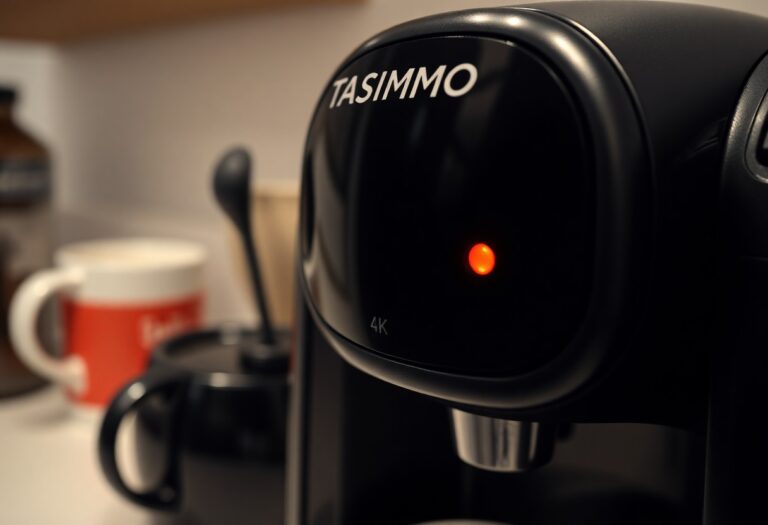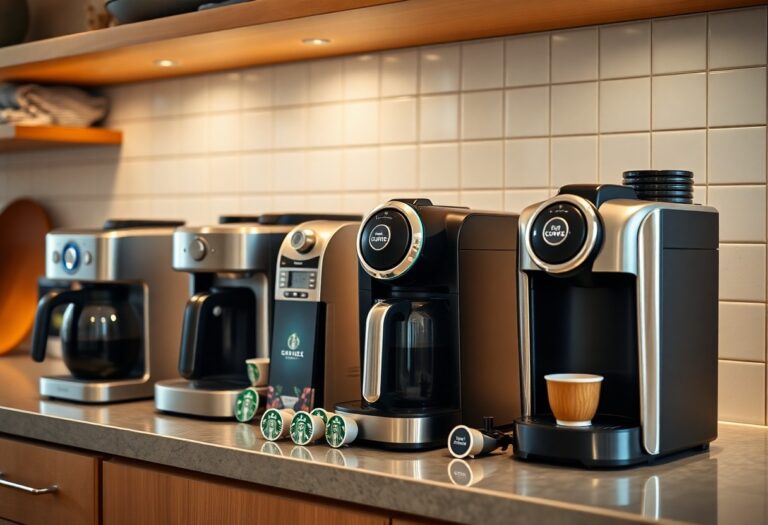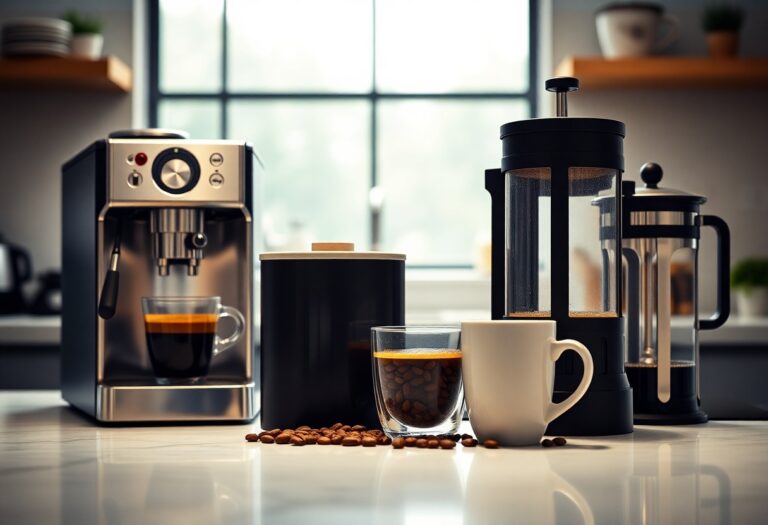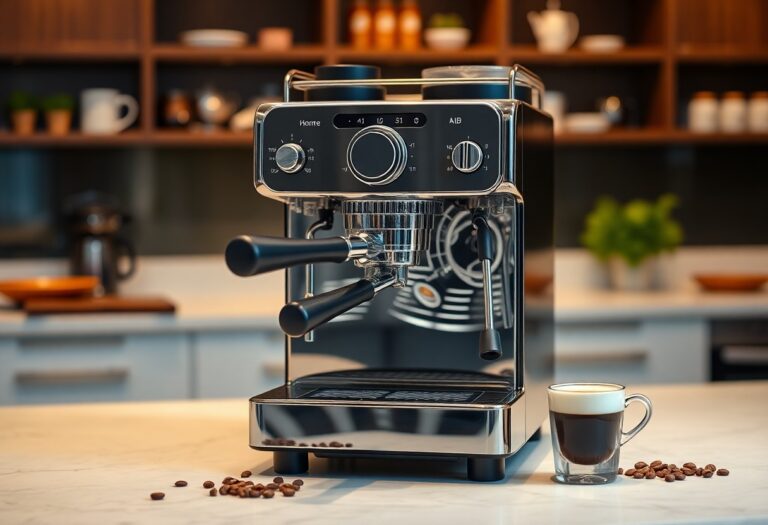What to Clean a Coffee Machine With – Cleaning Products
Most coffee enthusiasts know that a clean coffee machine is vital for the perfect brew, but you may be unsure of what cleaning products are safe and effective. Using the wrong cleaners can not only damage your machine but also pose risks to your health. Opt for natural ingredients like vinegar and baking soda or commercial coffee machine cleaners designed specifically for your model. For a complete guide, check out How to Clean a Coffee Maker for a Better Tasting Cup of Joe to ensure you’re using the best methods.

Key Takeaways:
- Use a mixture of water and white vinegar for an effective and natural cleaning solution.
- Descaling agents specifically designed for coffee machines can help remove mineral buildup.
- Regularly clean the removable parts of the coffee machine with soap and warm water for better hygiene.
- Coffee machine cleaning tablets can simplify the maintenance process and enhance flavor quality.
- Always consult the manufacturer’s instructions for recommended cleaning products and procedures to avoid damage.
The Essential Cleaning Agents for Coffee Machines
A variety of cleaning products can help maintain your coffee machine’s efficiency and flavor. You can explore options like homemade solutions or specialized products. We Set Out to Find the Best Coffee-Maker Cleaner to help you discover what’s best suited for your machine.
Natural Choices: Vinegar and Baking Soda
Vinegar and baking soda are popular natural options for cleaning coffee machines. Vinegar effectively removes mineral buildup and helps sanitize components, while baking soda can tackle stubborn stains and odors. To use these, run a mixture of equal parts vinegar and water through your machine, followed by two cycles of plain water, then add a baking soda paste for additional scrubbing where needed.
Commercial Cleaners: Pros and Cons
Pros and Cons
| Pros | Cons |
|---|---|
| Easy to use with specific instructions. | Can be more expensive than natural alternatives. |
| Often designed for specific coffee machines. | May contain harsh chemicals. |
| Quickly removes stubborn buildup. | Odors may linger after cleaning. |
| Prevents chalky residue and mineral deposits. | Some brands may leave unwanted residues. |
| Many are plant-based and eco-friendly. | Availability may be limited in local stores. |
Commercial cleaners are designed for specific cleaning tasks and often contain concentrated formulations for maximum effectiveness. They make it easy to maintain your coffee machine, although it’s important to check labels for any harsh chemicals that could affect the taste of your coffee or the machine’s longevity. Weighing their ease of use against potential downsides like cost and chemical residues can help you make an informed decision.

The Step-by-Step Guide to Effective Coffee Machine Cleaning
| Step | Action |
| 1 | Unplug your coffee machine and let it cool down. |
| 2 | Remove and wash all removable parts, like the carafe and filter basket. |
| 3 | Mix a solution of equal parts water and white vinegar. |
| 4 | Run the cleaning solution through a brewing cycle. |
| 5 | Run two additional cycles with clean water to rinse. |
| 6 | Wipe down the exterior and any non-removable internal components. |
Daily Maintenance Routines
Establishing daily maintenance routines can significantly extend your coffee machine’s lifespan. After each use, rinse the carafe and filter basket to prevent coffee oils and residues from building up. Wipe down the exterior with a damp cloth to remove any spills or splashes. A simple rinse and dry routine will go a long way in ensuring your coffee machine remains in optimal condition for your daily brews.
Deep Cleaning Techniques
Deep cleaning your coffee machine should occur at least monthly to remove mineral buildup and bacteria. Use a commercial descaling solution for efficient results or make your own with equal parts of water and white vinegar. Let the solution sit in the machine for a while, then run through a complete brewing cycle, followed by several rinse cycles with plain water to eliminate any residual cleaning solution.
For optimal deep cleaning, periodically disassemble components like the brew basket and water reservoir, if possible. Soaking these parts in warm, soapy water can break down stubborn stains and buildup. Avoid using abrasive materials while cleaning to prevent scratches. Maintaining a clean coffee machine not only enhances flavor but also improves its functionality over time.
The Impact of Different Coffee Beans on Cleaning Needs
The type of coffee beans you use can significantly affect the maintenance of your machine. Oily beans, often preferred for their rich flavors, leave behind stronger residues within the machine. This buildup necessitates more frequent and intensive cleaning to avoid clogs and preserve flavor integrity. On the other hand, non-oily beans tend to produce less residue, making cleaning somewhat easier. However, your choice in beans plays an integral role in how effectively you can maintain your coffee equipment.
Oily vs. Non-Oily Beans: What to Consider
Your choice between oily and non-oily beans influences not only taste but also cleaning frequency. Oily beans can lead to a sticky buildup that traps dirt and creates a breeding ground for bacteria, necessitating regular maintenance. Non-oily beans usually contribute less residue, offering a more straightforward cleaning process. Consider your brewing preferences and the time you’re willing to invest in machine upkeep.
Flavor Residue and Mineral Buildup
Flavor residue from your favorite coffee beans can accumulate over time, leading to a less-than-ideal brewing experience. Mineral buildup from hard water can also create blockages within your coffee machine, drastically affecting performance. Frequent cleaning with appropriate descaling agents and techniques can mitigate these issues, ensuring that each cup you brew retains its intended flavor profile.
Flavor residue often develops from the natural oils and acids released during the brewing process. This residue can cling to internal components such as the brew group and water lines, compromising the flavor of your coffee. Additionally, minerals from hard water can create limescale deposits, which may affect your machine’s heating efficiency and water flow. Regular cleaning sessions, particularly focusing on these areas, help maintain optimal performance and are important for achieving the perfect cup every time. Using an effective cleaning solution, like vinegar, can effectively dissolve both flavor residues and mineral deposits, prolonging the life of your coffee machine.
Common Mistakes and How to Avoid Them
Neglecting proper cleaning techniques can compromise both the flavor of your coffee and the lifespan of your machine. Common mistakes often stem from a lack of understanding about the correct cleaning products and areas that require your attention. By addressing these pitfalls, you can ensure a cleaner, better-performing coffee maker.
Misusing Cleaning Solutions
Improperly using cleaning solutions could lead to residue buildup or even damage your machine. Always follow the manufacturer’s instructions for diluting and applying cleaning substances. For example, using vinegar in excess can harm certain machine components, while soaps not designated for coffee makers might leave unpleasant tastes. Stick to recommended products to maintain optimal performance.
Overlooking Important Machine Parts
Focusing solely on obvious areas like the carafe and brew basket can create problems since grime often accumulates in hidden components. Areas such as the water reservoir, drip tray, and internal tubing require attention too. Regular deep cleaning of all parts, especially those that come in contact with water, ensures there’s no buildup affecting your coffee’s flavor and your machine’s functionality.
It’s easy to forget about less visible parts of your coffee machine, yet these areas can harbor bacteria and mineral deposits. For instance, the water reservoir can become a breeding ground for mold if not cleaned periodically. Disassembling your coffee maker’s components, following the manufacturer’s guide, allows you to access these parts and maintain their cleanliness effectively. Make this a regular part of your maintenance routine to promote better coffee quality and extend the life of your machine.
Expert Tips for Prolonging Your Coffee Machine’s Life
Maintaining your coffee machine’s performance can greatly enhance its durability and functionality. To ensure its longevity, prioritize regular cleaning and the right maintenance practices. Consider these efficient tips:
- Use filtered water to minimize mineral buildup
- Descale regularly based on coffee bean type and usage frequency
- Store your machine in a dry environment to prevent moisture damage
- Check for leaks and address them promptly
- Utilize manufacturer guidelines for servicing intervals
Assume that by following these guidelines, you can significantly extend the life of your coffee machine.
Frequency of Cleaning Recommendations
Establishing a cleaning routine based on usage can help keep your machine in optimal condition. For daily users, a light cleaning should be performed after each use, while deep cleaning with vinegar or descaling solutions is advisable every month. When brewing espresso, consider backflushing your machine weekly, if applicable. Adjusting this schedule according to your specific usage patterns can make a noticeable difference in machine longevity.
Signs It’s Time for a Professional Servicing
Certain indicators can signal the need for professional servicing of your coffee machine. If you notice inconsistent brewing temperature, unusual noises during operation, or persistent error messages, it’s time to seek professional help. Furthermore, if extraction times increase significantly and the machine fails to produce quality coffee, these can be signs of underlying issues requiring expert attention.
With time, failure to address these subtle signs can escalate into major problems. Regular professional servicing can prevent costly repairs while ensuring your coffee machine operates efficiently. Keep an eye out for any recurring issues or performance drops, as they could indicate deeper mechanical or electrical problems that need to be addressed by a licensed technician.
Final Words
Presently, ensuring your coffee machine remains in optimal condition is vital for enjoying a great cup of coffee. You can effectively clean your machine using white vinegar, baking soda, or specialized coffee machine cleaners. Each product is designed to remove mineral buildup and residues, enhancing the taste of your brew. Regular maintenance with these cleaning solutions will extend your machine’s lifespan and improve its performance, so make it a part of your routine for the best coffee experience possible.
FAQ
Q: What is the best cleaning product to use for a coffee machine?
A: The best cleaning product for a coffee machine often depends on the type of machine you have. For standard drip coffee makers, a mixture of white vinegar and water is highly effective. For espresso machines, specialized cleaning tablets or powders are recommended, as they are designed to remove coffee oils and mineral buildup without damaging the machine.
Q: Can I use bleach to clean my coffee machine?
A: It’s not advisable to use bleach for cleaning a coffee machine. Bleach can leave harmful residues that may affect the taste of your coffee and could potentially damage the internal components of the machine. Instead, stick to natural cleaners like vinegar or baking soda, which are both safe and effective.
Q: How often should I clean my coffee machine with cleaning products?
A: It’s generally recommended to clean your coffee machine every month to ensure optimal performance and extend its lifespan. For machines that are used daily, a more rigorous cleaning routine might be beneficial, which may include quarterly descaling with appropriate products to remove mineral deposits.
Q: Are there eco-friendly cleaning products for coffee machines?
A: Yes, there are several eco-friendly cleaning products available for coffee machines. Look for options that are labeled as biodegradable or made from natural ingredients. Additionally, a solution of equal parts white vinegar and water is an effective, environmentally-friendly alternative that can clean the machine without the use of harsh chemicals.
Q: How do I descale my coffee machine with cleaning products?
A: To descale your coffee machine, fill the reservoir with a descaling solution or a mixture of equal parts water and white vinegar. Run a full brew cycle without coffee grounds, then let the solution sit in the machine for about 15-30 minutes. Afterward, run several cycles with clean water to flush out any remaining solution and ensure no residues remain.







